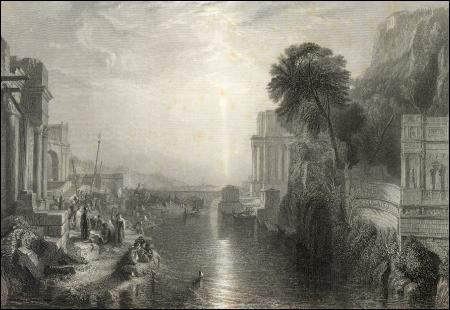
By Kind Permission of a Private Collection

By Kind Permission of a Private Collection
Turner 's Dido building Carthage: or the rise of the Carthaginian Empire - 1st book of Virgil's Æneid, oil on canvas, exhibited Royal Academy 1815; Turner Bequest, National Gallery, London ( Wilton P131).
Ruskin never had a very high opinion of Turner 's big early classical oils painted in emulation of Claude. He thought the two Carthages bad in colour, heavy in foreground, and covered in over-accumulated detail; since they showed little attention to the observation of the world of nature and reality, he placed them in the category of 'nonsense pictures,' along with other classical subjects such as Cicero's Villa.
Of the two, he marginally preferred this, in his Notes on the Turner Gallery at Marlborough House (1857), Ruskin describing The decline of the Carthaginian Empire as 'one of the deepest humiliations which Turner's art ever sustained... little more than an accumulation of Academy students' outlines, coloured brown' ( Works, 13.124).
Turner, however, regarded the painting as one of his most important, and it occupied one of the end walls of Turner's gallery. One of the provisions of his bequest to the nation was that it should hang, together with Sun rising through vapour (1807, Wilton P69), in the National Gallery alongside the Seaport and Mill by Claude.
J.M.W. Turner 1775-1851
Dido Building Carthage c.1815
Oil on canvas, 155.5 x 232cm
Exhibitions: RA1815 (158); Turner's Gallery 1835; Second Sight? National Gallery, London, Feb-April 1980
Engraving:
Engraved by E. Goodall, 1859
Steel engraving, 18x26.8cm
Engraved for the Turner Gallery, 1859-1875
Further Comments: Turner valued greatly this work during his lifetime, he would never sell it, and although he had bequeathed it to the National Gallery upon his death, he requested it be used as his winding-sheet.
Collection: National Gallery, London